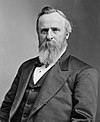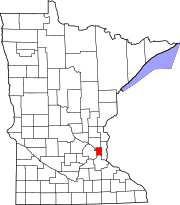Alexander Ramsey
Alexander Ramsey | |
|---|---|
 | |
| 34th United States Secretary of War | |
| In office December 10, 1879 – March 5, 1881 | |
| President | Rutherford B. Hayes |
| Preceded by | George W. McCrary |
| Succeeded by | Robert Lincoln |
| United States Senator from Minnesota | |
| In office March 4, 1863 – March 3, 1875 | |
| Preceded by | Henry Rice |
| Succeeded by | Samuel J. R. McMillan |
| 2nd Governor of Minnesota | |
| In office January 2, 1860 – July 10, 1863 | |
| Lieutenant | Ignatius L. Donnelly |
| Preceded by | Henry Sibley |
| Succeeded by | Henry Swift |
| 5th Mayor of Saint Paul, Minnesota | |
| In office 1855–1856 | |
| Preceded by | David Olmsted |
| Succeeded by | George Becker |
| 1st Governor of Minnesota Territory | |
| In office June 1, 1849 – May 15, 1853 | |
| Appointed by | Zachary Taylor |
| Preceded by | Position established |
| Succeeded by | Willis A. Gorman |
| Member of the U.S. House of Representatives from Pennsylvania's 14th district | |
| In office March 4, 1843 – March 3, 1847 | |
| Preceded by | James Irvin |
| Succeeded by | George Eckert |
| Personal details | |
| Born | September 8, 1815 Hummelstown, Pennsylvania, U.S. |
| Died | April 22, 1903 (aged 87) St. Paul, Minnesota, U.S. |
| Political party | Whig (Before 1857) Republican (1857—1903) |
| Spouse(s) | Anna Jenks |
| Education | Lafayette College Dickinson School of Law |
Alexander Ramsey (September 8, 1815 – April 22, 1903) was an American politician. He served as a Whig and Republican over a variety of offices between the 1840s and the 1880s. He was the first Minnesota Territorial Governor.
Early years and family[]
Born in Hummelstown, Pennsylvania, on September 8, 1815,[1] Alexander was the eldest of five children born to Thomas Ramsey and Elizabeth Kelker (also Kölliker or Köllker).[2] His father was a blacksmith who committed suicide[3] at age 42[4] when he went bankrupt in 1826,[1] after signing for a note of a friend.[2] Alexander lived with his uncle in Harrisburg, after his family split up to live with relatives.[2] His brother was Justus Cornelius Ramsey, who served in the Minnesota Territorial Legislature.[5]
Ramsey first studied carpentry at Lafayette College but left during his third year. He read law with Hamilton Alricks, and attended Judge John Reed's law school in Carlisle (now Penn State-Dickinson Law) in 1839. He was admitted to the Pennsylvania bar in 1839.[2]
In 1844 Ramsey married Anna Earl Jenks, daughter of Michael Hutchinson Jenks, and they had three children. Only one daughter, Marion, survived past childhood.[2]
Biography[]

Alexander Ramsey was elected from Pennsylvania as a Whig to the U.S. House of Representatives and served in the 28th and 29th congresses from March 4, 1843, to March 3, 1847. He served as the first Territorial Governor of Minnesota from June 1, 1849, to May 15, 1853, as a member of the Whig Party.
Ramsey was of Scottish and German ancestry.[6] In 1855, he became the mayor of St. Paul, Minnesota. Ramsey was elected the second Governor of Minnesota after statehood and served from January 2, 1860, to July 10, 1863. Ramsey is credited with being the first Union governor to commit troops during the American Civil War. He happened to be in Washington, D.C., when fighting broke out. When he heard about the firing on Fort Sumter he went straight to the White House and offered Minnesota's services to Abraham Lincoln.
He resigned the governorship to become a U.S. Senator, having been elected to that post in 1863 as a Republican. He was re-elected in 1869 and held the office until March 3, 1875, serving in the 38th, 39th, 40th, 41st, 42nd, and 43rd congresses. He supported the Radical Republicans,[7] who called for vigorous prosecution of the Civil War, and a military reconstruction of the South.[8] He voted for the Impeachment of Andrew Johnson.[8]
Ramsey called for the killing or removal of the Mdewakanton and Wahpekute Dakota from the state of Minnesota during the Dakota War of 1862. After pressing the Dakota to sell their land, he and other officials diverted the Dakota's money to themselves, leaving the Dakota without their land or the treaty money.[9] In response, some of the Dakota attacked American settlements, resulting in the death of at least 800 civilian men, women and children, and the displacement of thousands more.[10] In a message to the state legislature on September 9, 1862, Ramsey said: "The Sioux Indians of Minnesota must be exterminated or driven forever beyond the borders of the State," which he justified by accusing the Indians of various outrages against the white settlers and violations of their treaties.[11] In 1863, in response to continued raids on civilian settlers, he authorized bounty payments on Dakota scalps.[12]
Ramsey served as Secretary of War from 1879 to 1881, under President Rutherford B. Hayes.[13] He was one of the commissioners to govern Utah from 1882 to 1886 under the Edmunds Act.[13] The act made it illegal for polygamists to vote or hold office. Ramsey and four others were defendants in the Supreme Court case Murphy v. Ramsey, 114 U.S. 15 (1885). The Supreme Court upheld the federal law that denied polygamists the right to vote.
Legacy[]
- The Minnesota Historical Society preserves his home, the Alexander Ramsey House as a museum. It was added to the National Register of Historic Places in 1969.
A number of counties, towns, parks, and schools are named after Ramsey, including:
- Ramsey County, Minnesota,[14]
- Ramsey County, North Dakota
- The city of Ramsey, Minnesota
- The city of Ramsey, Illinois,[15]
- Alexander Ramsey Park, located in Redwood Falls, Minnesota, is the largest municipal park in Minnesota.
- Ramsey Park in Stillwater, Minnesota
- Ramsey Middle School in Saint Paul, Minnesota, St. Paul School Board to consider name change in 2021,[16] with school name no longer supported by either the school's staff or students.[17]
- Alexander Ramsey Elementary School in Montevideo, Minnesota.
- Justice Page Middle School in Minneapolis, Minnesota was formerly named after him when it was first founded in 1932 (Ramsey International Fine Arts Center and formerly Alexander Ramsey Junior High School).[18] In the 2016–17 school year, a student-initiated effort to rename Ramsey Middle School resulted in renaming the school after Alan Page, the first African-American Minnesota Supreme Court justice.[19]
He was the namesake of the Liberty Ship SS Alexander Ramsey launched in 1942.
References[]
- United States Congress. "Alexander Ramsey (id: R000026)". Biographical Directory of the United States Congress. Retrieved on 2009-03-22
- ^ Jump up to: a b Helen McCann White (1974). "Guide to a Microfilm Edition of: The Alexander Ramsey Papers and Records" (PDF). Minnesota Historical Society. Retrieved February 13, 2016.
- ^ Jump up to: a b c d e Butler, William E. (February 2000). "Alexander Ramsey". American National Biography Online. Retrieved February 13, 2016.
- ^ Steiner, Andy (February 12, 2016). "Out of the shadows: Mental Health Resources meets $1 million fundraising goal". MinnPost. Retrieved February 15, 2016.
- ^ "Thomas Ramsey: 1784–1826". Ancestry.com. Retrieved February 15, 2016.
- ^ "Ramsey, Justus Cornelius "J.C." - Legislator Record - Minnesota Legislators Past & Present". www.lrl.mn.gov.
- ^ Minnesota Historical Society collections, Volume 13 By Minnesota Historical Society, page 5
- ^ Thomas A. McMullin; David Allan Walker (1 January 1984). Biographical Directory of American Territorial Governors. Meckler. ISBN 978-0-930466-11-4.
- ^ Jump up to: a b Spencer C. Tucker; Paul G. Pierpaoli Jr. (24 March 2015). American Civil War: A State-by-State Encyclopedia [2 volumes]: A State-by-State Encyclopedia. ABC-CLIO. pp. 416–. ISBN 978-1-59884-529-7.
- ^ Anderson, Gary Clayton (2019). Massacre in Minnesota: The Dakota War of 1862, the Most Violent Ethnic Conflict in American History. University of Oklahoma Press. pp. 26–33. ISBN 9780806164342.
- ^ "Second Annual Message | The American Presidency Project". www.presidency.ucsb.edu.
- ^ Ramsey, Alexander (1862). "Message of Governor Ramsey to the Legislature of Minnesota, delivered September 9, 1862." In Executive Documents of the State of Minnesota, for the year 1862. Wm. R. Marshall: 1863.
- ^ Wingerd, Mary Lethert; Delegard, annotated by Kirsten (2010). North country : the making of Minnesota. Minneapolis: University of Minnesota Press. p. 329–330. ISBN 978-0-8166-4868-9.
- ^ Jump up to: a b "THE MEN WHO IMPEACHED ANDREW JOHNSON". McBride's Magazine. J.B. Lippincott and Company. 1899. pp. 518–.
- ^ Upham, Warren (1920). Minnesota Geographic Names: Their Origin and Historic Significance. Minnesota Historical Society. p. 436.
- ^ Allan H. Keith, Historical Stories: About Greenville and Bond County, IL. Consulted on August 15, 2007.
- ^ Golden, Eric (March 23, 2021). "St. Paul will consider renaming Ramsey Middle School". Star Tribune. Retrieved May 23, 2021.
- ^ Verges, Josh (April 13, 2021). "Students, staff urge St. Paul school board to rename Ramsey Middle School". Pioneer Press. Retrieved May 23, 2021.
- ^ "History - MPS_CMF". page.mpls.k12.mn.us.
- ^ "MPS_CMF". page.mpls.k12.mn.us.
External links[]
 Media related to Alexander Ramsey at Wikimedia Commons
Media related to Alexander Ramsey at Wikimedia Commons- Biographical information, gubernatorial records, and Ramsey's personal papers are available for research use at the Minnesota Historical Society.
- "Alexander Ramsey". Find a Grave. Retrieved 2009-03-22.
- 1815 births
- 1903 deaths
- People from Hummelstown, Pennsylvania
- American Methodists
- Governors of Minnesota
- Governors of Minnesota Territory
- Mayors of Saint Paul, Minnesota
- United States Secretaries of War
- United States senators from Minnesota
- Minnesota Republicans
- Members of the United States House of Representatives from Pennsylvania
- Pennsylvania Whigs
- People of Minnesota in the American Civil War
- Minnesota Whigs
- Republican Party United States senators
- Hayes administration cabinet members
- Union state governors
- Whig Party members of the United States House of Representatives
- Republican Party state governors of the United States
- 19th-century American politicians
- Ramsey County, Minnesota





